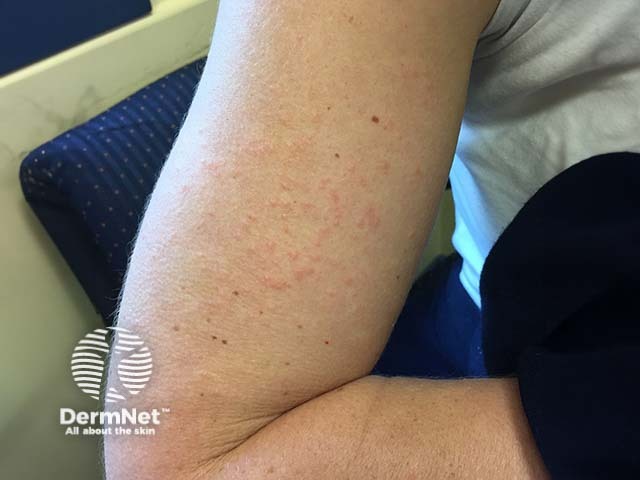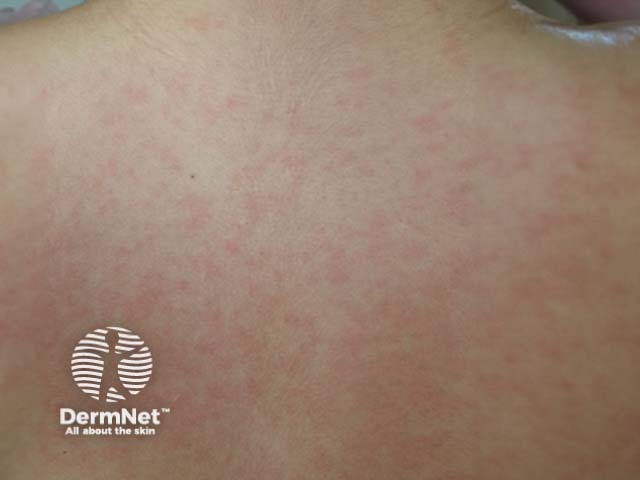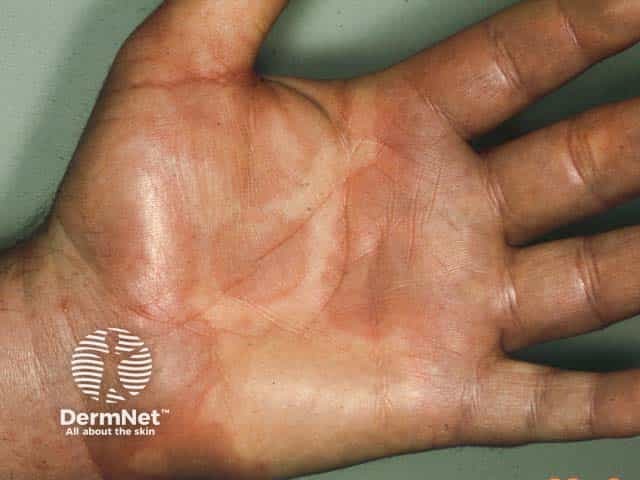Main menu
Common skin conditions

NEWS
Join DermNet PRO
Read more
Quick links
Author: Dr Sarah Hill, Dermatology Registrar, Waikato Hospital, Hamilton, New Zealand, 2007. Updated by Dr Catherine Tian, House Officer Auckland City Hospital. DermNet New Zealand Editor in Chief: Associate A/Prof Amanda Oakley, Dermatologist, Hamilton, New Zealand. Medical Editor: Dr Helen Gordon, Auckland, New Zealand. Copy edited by Gus Mitchell. August 2020.
Introduction Demographics Causes Transmission Clinical features Mucocutaneous features Diagnosis Differential diagnoses Treatment Prevention Complications Prognosis Other diseases caused by Epstein-Barr virus
Submit your photo of infectious mononucleosis
Infectious mononucleosis is a common infectious disease caused by Epstein-Barr virus (EBV). It is more commonly known as glandular fever.
Infectious mononucleosis typically affects young adults aged 15–25 years. It is equally common in both sexes and affects all races. Up to nearly 95% of people have had EBV infection by the time they are adults. The disease occurs worldwide with no seasonal predilection.
Infectious mononucleosis is a contagious viral infection usually caused by EBV (human herpesvirus-4, HHV4), a gamma-herpesviridae DNA virus. EBV is implicated in a wide range of human diseases, many of which have mucocutaneous manifestations that can be acute or chronic.
Infectious mononucleosis can also be caused by cytomegalovirus (CMV) particularly in an older age group than the EBV-related patients.
EBV is passed from person to person by saliva through intimate contacts such as kissing, or via objects such as a toothbrush or drinking glass. The virus survives on an object while it remains moist. EBV can also be spread through blood and semen during sexual contact, blood transfusion, organ transplantation, and other procedures. Spread to children is presumed to be from parents or siblings who carry EBV and shed the virus intermittently.
The clinical manifestations of infection are dependent on the interaction between virus and host immune system. The incubation period from contact until symptoms is usually 6-7 weeks.
Infectious mononucleosis presents typically in 75% of young adults; 15% have an atypical presentation, and infection in 10% is asymptomatic. Children are often asymptomatic or presumed to have a non-specific viral infection.
There are two typical presentations:
The typical exanthem of infectious mononucleosis is an acute, generalised maculopapular rash. The exanthem:
A more intense and extensive cutaneous eruption appears in up to 90% of patients with infectious mononucleosis 2–10 days after starting antibiotics. These include ampicillin, azithromycin, amoxicillin, cephalosporins, tetracyclines, and macrolides such as erythromycin. Recent studies suggest the actual rate of this antibiotic rash is much lower than previously reported.
The drug allergy is usually transient. However, re-exposure to the antibiotic may sometimes result in recurrence of rash years later.
Palatal petechiae are found on the hard and soft palate in 50% of young adults in the first few days of the illness.
Cholestatic jaundice due to liver involvement is itchy, resulting in excoriations and bruising.
Other less commonly reported skin signs of infectious mononucleosis include immune thrombocytopenic purpura, cold urticaria, and erythema nodosum.

Exanthem of infectious mononucleosis

Rash due to infectious mononucleosis plus amoxicillin

Infectious mononucleosis: urticaria
Following the acute symptomatic phase, EBV persists in memory B cells in the tonsils and peripheral circulation of the infected host in a latent non-lethal carrier state throughout life. Virus can be shed intermittently and infection may reactivate.
The clinical features and a positive heterophile test are usually sufficient to diagnose infectious mononucleosis.
Abdominal ultrasonography can evaluate hepatosplenomegaly.
The main differential diagnoses of acute infectious mononucleosis are:
Other differential diagnoses include streptococcal pharyngitis (which may co-exist), leukaemia, tonsillitis, diphtheria, the common cold, influenza, and COVID-19.
Treatment options for infectious mononucleosis are typically supportive in nature, such as:
Less common treatment options include:
There is currently no vaccine to protect against EBV infection. Prevention involves social hygiene, and avoiding the sharing of drinks, food, or personal items.
Infectious mononucleosis complications include:
Recovery from the acute phase of the initial EBV infection in healthy and immunocompetent individuals is generally complete in a few weeks, but it can take several months to feel completely well again. Prolonged lethargy, tiredness, and joint pain are common, often lasting 6 months or more.
EBV causes life-long infection as the virus remains dormant in B lymphocytes. Intact immune response prevents progressive disease due to EBV. However, immune suppression or another illness has the potential to reactivate the virus causing vague and subclinical symptoms and, rarely, aggressive disease. During this phase, the virus can be spread to others.
Other skin manifestations of EBV infection include:
Other diseases associated with EBV include: